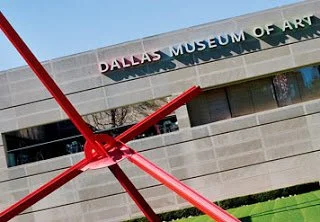Art and Contemplation
For the past three weeks I’ve been teaching Creative Writing at DTS. Picture grad-school students, nine men and women (perfect class size) of different ages and backgrounds, spending three hours together weekday mornings baring their souls. Some days when Texas' tornado-alley weather hit a lull, we got to meet in the library courtyard. Despite the constant interruption of airplanes, we enjoyed breezes and sunshine. May mornings in Texas provide somewhat of a payoff for enduring July and August.
A highlight of the semester for my students is our field trip to the Dallas Museum of Art (DMA). This year Mike Hill, a DMA preparer (who used to attend Reinhardt back when we went there) put together our adventure. Mike began by quoting an art critic named Klaus Ottmann. Discussing contemporary art, Ottmann said that it “requires sustained contemplation, even communion, not interpretation, explanation, or decoding.”
Mike then led us to contemplate a number of pieces that he disliked when he first encountered them but that, over time and repeated interaction, have come to be meaningful to him. He pointed out that art can speak to something deep inside of us and can call to us in spite of ourselves, but for it to do so, we have to be willing to park ourselves in front of it and observe.
First he showed us “You Can’t Lay Down Your Memory” by Tejo Remy. This link has a photo of one version of this work; the DMA’s is similar. (No photos allowed of temporary exhibits—sorry.)
The other is a piece called “Perfect Lovers.” It’s part of a new exhibit, “Silence and Time,” which opens to the public on Sunday. (Fun to get a sneak preview.) It consists of two plain, round clocks hung touching each other high on a white wall. The artist stipulated that the clocks must run on battery power, not electricity. At first glance, the pieces looked like a couple of boring ol’ kitchen time-keepers. Why two?
But then we considered that they could also represent the ordinary. And they were in synch, like two people who love each other. And circles can represent eternity, but time on a battery has an end, meaning one will stop before the other.
What initially seemed commonplace took on profound meaning.
We ended in a room full of work by Fergus Feehily. The artist’s website provides a good idea of what he does. As we all stood looking at a collection of this almost minimalistic work, we considered the show as a whole. Mike told us he thought of Feehily’s work as having a “bold humility.”
For the last 45 minutes, we turned everybody loose to explore on their own and come up with something to write about. Meanwhile, I wandered in to see, “Line and Form: Frank Lloyd Wright and the Wasmuth Portfolio,” on loan to the DMA till July 17. During my time in Maryland last month, my friend Erin’s girls told me they were studying Wright’s work and they showed me models of the Guggenheim and Fallingwater they had constructed. I enjoyed the exhibit even more knowing girls under the age of 15 would consider it a worthy subject.
I invited groups of four or five to lunch once during the semester. And yesterday was our final group. One of the invitees asked if we could come to her home nearby rather than going out to eat. She served up some chicken-salad sandwiches while we carried on about our museum trip. The private-home setting also allowed for an impromptu one-man drama by the actor among us.
Mike came to campus to join us in class today to hear what students wrote. I suspect he will never again look at one painting of a big blue man standing in a puddle without remembering that my student's "take" on it was that he lived too close to a nuclear plant. We ended the semester laughing, crying and praying.
Tonight my parents arrive from Oregon for a big celebration of my niece's graduation. And then I really do need to start tackling that dissertation.

